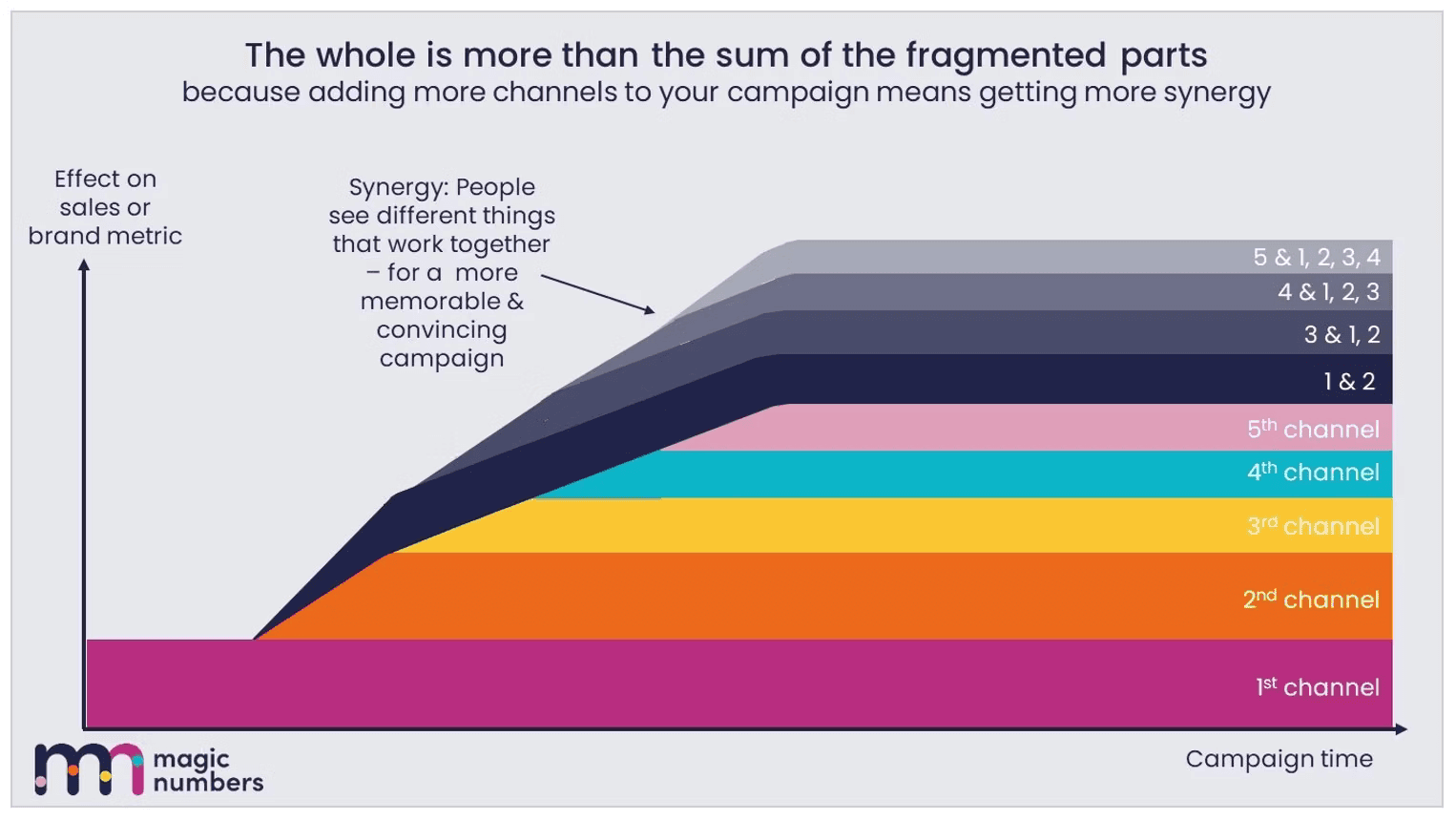Google and Meta are the bread and butter of any digital marketing strategy and are often the very first channels that brands venture into when they are thinking more seriously about their online presence.
And of course brands can survive pretty well online with just these 2 channels, if they are optimised incredibly well. But for brands with ambitious targets or those who have reached a revenue plateau and see their current media spend reaping less rewards, it may be time to diversify your channel mix and really focus on what a multi channel approach looks like for your brand and more importantly, your audience.
To understand why a multi channel approach is so important, I think its vital to look at the behaviour of the consumer.
Multi Touch Consumer Behaviour
All marketers have heard the 8 touch point rule; that generally, users need 8 different touch points from discovery to purchase. At some point this general rule of thumb seems to have disappeared as platforms find even more ways of serving bottom of funnel campaign types with conversion as the objectives. Not everyone will immediately be in the market to purchase your product. Even more so if they are browsing social media for entertainment purposes. So we need to go back to that 8 touch point frame of mind.
And when we think of those 8 touch points, they are not just happening on Meta and Google. We have newer channels emerging like the titan of Tiktok and more nuanced platforms like Pinterest, Reddit, Twitch, OTT apps like Amazon Prime and Netflix. According to data from The Tech Report, the average person has around 80 installed apps, 9 that they use regularly and 30 used within a single month. Armed with this information, brands should be looking at how to become visible, but not intrusive, on as many of these platforms as possible.
Depending the price of your product, this consideration phase could be even longer. For luxury brands in particular the journey between a consumer discovering your brand for the first time, becoming a customer and then repurchasing on multiple occasions, requires a carefully planned strategy and well told brand story.
Brand Building
The other positive of investing in a multi channel approach is the knock on effect it has on brand building. Having a presence on various platforms and tailoring creative specifically for the use of each platform helps build an interesting and positive perception of your brand. Providing you have your targeting and messaging consistent, you'll be constantly inviting new users to learn more about your brand and leading them down a path to purchase.
In this modern digital age, your strategy shouldn't be siloed and complex. Its about giving your users options and variety of content in many spaces. If you can link together numerous small exposures, it can be more effective that your one big brand campaign that you've only launched on one channel.
And in the long run, research from Binet and Field has showed that brand building is more effective at long term incremental growth of sales than repeatedly running sales activation/ short term performance activity. So it does really pay to invest in this type of content based activity.
Google and Meta are the bread and butter of any digital marketing strategy and are often the very first channels that brands venture into when they are thinking more seriously about their online presence.
And of course brands can survive pretty well online with just these 2 channels, if they are optimised incredibly well. But for brands with ambitious targets or those who have reached a revenue plateau and see their current media spend reaping less rewards, it may be time to diversify your channel mix and really focus on what a multi channel approach looks like for your brand and more importantly, your audience.
To understand why a multi channel approach is so important, I think its vital to look at the behaviour of the consumer.
Multi Touch Consumer Behaviour
All marketers have heard the 8 touch point rule; that generally, users need 8 different touch points from discovery to purchase. At some point this general rule of thumb seems to have disappeared as platforms find even more ways of serving bottom of funnel campaign types with conversion as the objectives. Not everyone will immediately be in the market to purchase your product. Even more so if they are browsing social media for entertainment purposes. So we need to go back to that 8 touch point frame of mind.
And when we think of those 8 touch points, they are not just happening on Meta and Google. We have newer channels emerging like the titan of Tiktok and more nuanced platforms like Pinterest, Reddit, Twitch, OTT apps like Amazon Prime and Netflix. According to data from The Tech Report, the average person has around 80 installed apps, 9 that they use regularly and 30 used within a single month. Armed with this information, brands should be looking at how to become visible, but not intrusive, on as many of these platforms as possible.
Depending the price of your product, this consideration phase could be even longer. For luxury brands in particular the journey between a consumer discovering your brand for the first time, becoming a customer and then repurchasing on multiple occasions, requires a carefully planned strategy and well told brand story.
Brand Building
The other positive of investing in a multi channel approach is the knock on effect it has on brand building. Having a presence on various platforms and tailoring creative specifically for the use of each platform helps build an interesting and positive perception of your brand. Providing you have your targeting and messaging consistent, you'll be constantly inviting new users to learn more about your brand and leading them down a path to purchase.
In this modern digital age, your strategy shouldn't be siloed and complex. Its about giving your users options and variety of content in many spaces. If you can link together numerous small exposures, it can be more effective that your one big brand campaign that you've only launched on one channel.
And in the long run, research from Binet and Field has showed that brand building is more effective at long term incremental growth of sales than repeatedly running sales activation/ short term performance activity. So it does really pay to invest in this type of content based activity.
Incremental Gains
Brand building is a great bi-product of these tiny touch points but it has been proven that having activity on multiple channels has a direct and positive effect on ROI and revenue.
Recent research conducted by Magic Numbers shows how having multiple channels involved in your strategy directly effect sales as well as encouraging a positive brand perception. So whilst you can get favourable results but running each channel independent of one another, when they begin to work together, thats when we start to see real success and real growth.

How Do I Know If My Channels Are Working Together?
The first step is actually being present on more than one channel. As mentioned previously, there is often a reliance on Meta and Google but exploring a wider variety of channels doesn't need to be complex.
Reporting.
The key to understanding how your channels work together is taking a step back and viewing things on a larger scale. Yes, it's important to continue to look at the last click ROAS of each channel and campaign but being able to see how effective channels are introducing users to the brand and how effective channels are at influencing purchases is equally as important.
There's no easy way of being able to measure this. Using reporting metrics like assisted conversions could be 1 place to start if you are reporting through Google Analytics or looking at native platform analytics. 1st Click attribution models can be a good place to start when looking for good introducers.
To be able to see more granular detail, you'd need to invest in a attribution tool which is able to map out all interactions across a purchase journey and assess influence of each channel on the other.
Content and Creative Assets.
Content and your creative assets are some of the most important elements of your digital strategy, especially when you're exploring visual platforms such as Tiktok and Pinterest. The real art is making sure that the content and assets that you are serving are tailored for each channel's nuances but tell tell a consistent brand story and allow the brand to be recognisable from one platform to the next.
As an example, if you are a luxury luggage brand:
You are serving your big budget brand video across Youtube and also CTV such as Amazon Prime. The story showcases your brand personality and evokes the emotion you want your brand to be synonymous with. The video showcases how the brand can take the stress out of travel and allow you to find peace and wonder in each little part of the journey.
You have created UGC content to serve across Tiktok and test on Instagram. Content creators are filming packing videos for their long cross country train journeys. Follow up videos show the beauty of the journey, the views from the train and how the luggage has allowed them to relax.
You also have still images turned into carousels across Meta and Pinterest showing the luggage in its "natural habitat"; a busy train station; airport security; a hotel lobby. Amongst all the chaos, the luggage and its owner looks peaceful.
This example should demonstrate how you can create different styles of content and creative assets but all sit under the same brand story and one relates to the other, creating a cohesive experience for the user.
So to conclude, don't just reply on Meta and Google. Explore and test new channels with creative content tailored for each channel, and take a look at your reporting set up and how you can better optimise reporting cross channel success.






